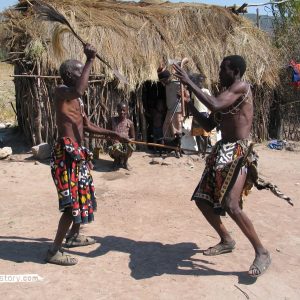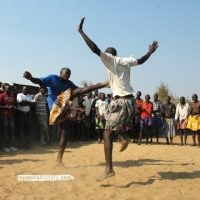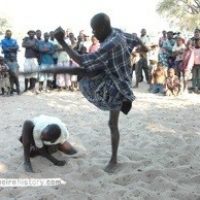Combat Games

Traditional weapons
Most of the traditional weapons (sticks, axes, spears and cudgels) are used to herd cattle or to protect them from preying animals or thieves.
Hence stick-fighting is often practised whilst looking after cattle, as demonstrated in the film by Vakussunga and Lito.
Combat games often took place in the corral and songs that accompany them refer to cattle or wild animals.
Kambangula and ondjumbo
The film documents the open-hand fight kambangula (also called m’bangula or khandeka).
Kambangula is still widely practised in Southern Angola, not only by the Nyaneka but also by neighbouring peoples such as the Kwanyama or the Ovimbundu.
Adolescents and young men perform it on all kinds of occasions. In the past it was also commonly used during fights. In another variant (ondjumbo), fighters also attempt to throw each other to the ground.
Engolo
Engolo practice has been much more restricted geographically, at least in recent memory. As far as the project could verify, its practice has been limited to the Nkhumbi sub-group of the Nyaneka, to the point of constituting one marker of their ethnic identity.
Furthermore, it has not been regularly performed since the 1970s. Hence a number of its former techniques, while documented by Neves e Sousa, are no longer in use and many of the lyrics that accompanied it no longer remembered.
The film presents a selection of the interviews with experienced practitioners, through which the research project aims to document present performance, but also to rescue the memory of the game. These specialists clarify that engolo was practised in a range of contexts, from everyday practice in the corral to celebrations such as efiko or the return of the cattle from the winter pastures (sambos). The long civil war, including South African military occupation of large parts of Southern Angola as well as ongoing modernisation have contributed to the gradual decline of engolo and other folk practices. The project supports a network of practitioners who aim to rescue engolo from oblivion. Since 2010 some younger people have begun to learn it as can be seen from the final engolo scene in the film.





